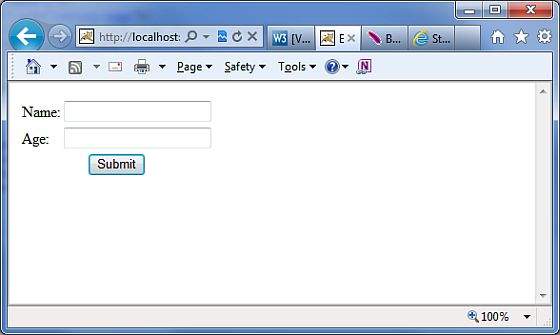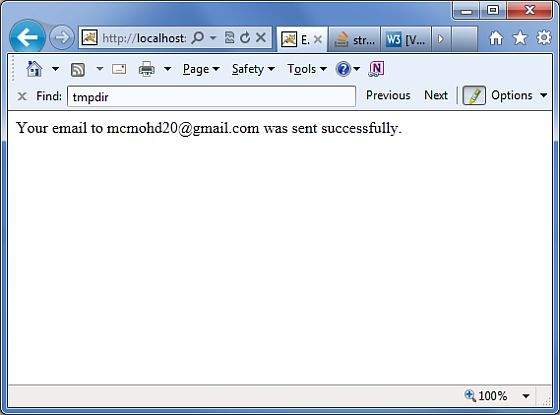
- Struts 2 教程
- Struts2 - 主页
- Struts2 - 基本 MVC 架构
- Struts2 - 概述
- Struts2 - 环境设置
- Struts2 - 架构
- Struts2 - 示例
- Struts2 - 配置
- Struts2 - 动作
- Struts2 - 拦截器
- Struts2 - 结果类型
- Struts2 - 价值堆栈/OGNL
- Struts2 - 文件上传
- Struts2 - 数据库访问
- Struts2 - 发送电子邮件
- Struts2 - 验证
- Struts2 - 本地化
- Struts2 - 类型转换
- Struts2 - 主题/模板
- Struts2 - 异常处理
- Struts2 - 注释
- Struts 2 集成
- Struts2-Spring
- Struts2 - 瓷砖
- Struts2-Hibernate
- Struts 2 有用资源
- Struts2 - 问题与解答
- Struts2 - 快速指南
- Struts2 - 有用的资源
- Struts2 - 讨论
Struts 2 - 发送电子邮件
本章介绍如何使用 Struts 2 应用程序发送电子邮件。
对于本练习,您需要从JavaMail API 1.4.4下载并安装 mail.jar ,并将mail.jar文件放置在 WEB-INF\lib 文件夹中,然后继续执行创建操作、视图和配置的标准步骤文件。
创建动作
下一步是创建一个负责发送电子邮件的操作方法。让我们创建一个名为Emailer.java的新类,其中包含以下内容。
package com.tutorialspoint.struts2;
import java.util.Properties;
import javax.mail.Message;
import javax.mail.PasswordAuthentication;
import javax.mail.Session;
import javax.mail.Transport;
import javax.mail.internet.InternetAddress;
import javax.mail.internet.MimeMessage;
import com.opensymphony.xwork2.ActionSupport;
public class Emailer extends ActionSupport {
private String from;
private String password;
private String to;
private String subject;
private String body;
static Properties properties = new Properties();
static {
properties.put("mail.smtp.host", "smtp.gmail.com");
properties.put("mail.smtp.socketFactory.port", "465");
properties.put("mail.smtp.socketFactory.class",
"javax.net.ssl.SSLSocketFactory");
properties.put("mail.smtp.auth", "true");
properties.put("mail.smtp.port", "465");
}
public String execute() {
String ret = SUCCESS;
try {
Session session = Session.getDefaultInstance(properties,
new javax.mail.Authenticator() {
protected PasswordAuthentication
getPasswordAuthentication() {
return new
PasswordAuthentication(from, password);
}
}
);
Message message = new MimeMessage(session);
message.setFrom(new InternetAddress(from));
message.setRecipients(Message.RecipientType.TO,
InternetAddress.parse(to));
message.setSubject(subject);
message.setText(body);
Transport.send(message);
} catch(Exception e) {
ret = ERROR;
e.printStackTrace();
}
return ret;
}
public String getFrom() {
return from;
}
public void setFrom(String from) {
this.from = from;
}
public String getPassword() {
return password;
}
public void setPassword(String password) {
this.password = password;
}
public String getTo() {
return to;
}
public void setTo(String to) {
this.to = to;
}
public String getSubject() {
return subject;
}
public void setSubject(String subject) {
this.subject = subject;
}
public String getBody() {
return body;
}
public void setBody(String body) {
this.body = body;
}
public static Properties getProperties() {
return properties;
}
public static void setProperties(Properties properties) {
Emailer.properties = properties;
}
}
如上面的源代码所示,Emailer.java具有与下面给出的 email.jsp 页面中的表单属性相对应的属性。这些属性是 -
From - 发件人的电子邮件地址。由于我们使用的是 Google 的 SMTP,因此我们需要一个有效的 gtalk id
密码- 上述帐户的密码
收件人- 将电子邮件发送给谁?
主题- 电子邮件的主题
正文- 实际的电子邮件消息
我们没有考虑对上述字段进行任何验证,验证将在下一章中添加。现在让我们看一下execute() 方法。execute() 方法使用 javax Mail 库通过提供的参数发送电子邮件。如果邮件发送成功,action 返回 SUCCESS,否则返回 ERROR。
创建主页
让我们编写主页JSP文件index.jsp,它将用于收集上述电子邮件相关信息 -
<%@ page language = "java" contentType = "text/html; charset = ISO-8859-1"
pageEncoding = "ISO-8859-1"%>
<%@ taglib prefix = "s" uri = "/struts-tags"%>
<!DOCTYPE html PUBLIC "-//W3C//DTD HTML 4.01 Transitional//EN"
"http://www.w3.org/TR/html4/loose.dtd">
<html>
<head>
<title>Email Form</title>
</head>
<body>
<em>The form below uses Google's SMTP server.
So you need to enter a gmail username and password
</em>
<form action = "emailer" method = "post">
<label for = "from">From</label><br/>
<input type = "text" name = "from"/><br/>
<label for = "password">Password</label><br/>
<input type = "password" name = "password"/><br/>
<label for = "to">To</label><br/>
<input type = "text" name = "to"/><br/>
<label for = "subject">Subject</label><br/>
<input type = "text" name = "subject"/><br/>
<label for = "body">Body</label><br/>
<input type = "text" name = "body"/><br/>
<input type = "submit" value = "Send Email"/>
</form>
</body>
</html>
创建视图
我们将使用 JSP 文件success.jsp,如果操作返回 SUCCESS,将调用该文件,但如果操作返回错误,我们将有另一个视图文件。
<%@ page language = "java" contentType = "text/html; charset = ISO-8859-1"
pageEncoding = "ISO-8859-1"%>
<%@ taglib prefix = "s" uri = "/struts-tags"%>
<!DOCTYPE html PUBLIC "-//W3C//DTD HTML 4.01 Transitional//EN"
"http://www.w3.org/TR/html4/loose.dtd">
<html>
<head>
<title>Email Success</title>
</head>
<body>
Your email to <s:property value = "to"/> was sent successfully.
</body>
</html>
以下是操作返回错误时的视图文件error.jsp 。
<%@ page language = "java" contentType = "text/html; charset = ISO-8859-1"
pageEncoding = "ISO-8859-1"%>
<%@ taglib prefix = "s" uri = "/struts-tags"%>
<!DOCTYPE html PUBLIC "-//W3C//DTD HTML 4.01 Transitional//EN"
"http://www.w3.org/TR/html4/loose.dtd">
<html>
<head>
<title>Email Error</title>
</head>
<body>
There is a problem sending your email to <s:property value = "to"/>.
</body>
</html>
配置文件
现在让我们使用 struts.xml 配置文件将所有内容放在一起,如下所示 -
<?xml version = "1.0" Encoding = "UTF-8"?>
<!DOCTYPE struts PUBLIC
"-//Apache Software Foundation//DTD Struts Configuration 2.0//EN"
"http://struts.apache.org/dtds/struts-2.0.dtd">
<struts>
<constant name = "struts.devMode" value = "true" />
<package name = "helloworld" extends = "struts-default">
<action name = "emailer"
class = "com.tutorialspoint.struts2.Emailer"
method = "execute">
<result name = "success">/success.jsp</result>
<result name = "error">/error.jsp</result>
</action>
</package>
</struts>
以下是web.xml文件的内容-
<?xml version = "1.0" Encoding = "UTF-8"?>
<web-app xmlns:xsi = "http://www.w3.org/2001/XMLSchema-instance"
xmlns = "http://java.sun.com/xml/ns/javaee"
xmlns:web = "http://java.sun.com/xml/ns/javaee/web-app_2_5.xsd"
xsi:schemaLocation = "http://java.sun.com/xml/ns/javaee
http://java.sun.com/xml/ns/javaee/web-app_3_0.xsd"
id = "WebApp_ID" version = "3.0">
<display-name>Struts 2</display-name>
<welcome-file-list>
<welcome-file>index.jsp</welcome-file>
</welcome-file-list>
<filter>
<filter-name>struts2</filter-name>
<filter-class>
org.apache.struts2.dispatcher.FilterDispatcher
</filter-class>
</filter>
<filter-mapping>
<filter-name>struts2</filter-name>
<url-pattern>/*</url-pattern>
</filter-mapping>
</web-app>
现在,右键单击项目名称,然后单击“导出”>“WAR 文件”以创建一个 War 文件。然后将此 WAR 部署到 Tomcat 的 webapps 目录中。最后,启动 Tomcat 服务器并尝试访问 URL http://localhost:8080/HelloWorldStruts2/index.jsp。这将产生以下屏幕 -

输入所需信息并单击“发送电子邮件”按钮。如果一切顺利,那么您应该会看到以下页面。
